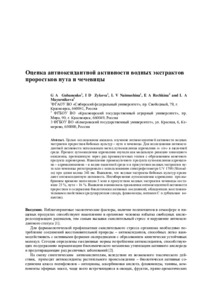Antioxidant activity evaluation of aqueous extracts of chickpea and lentil seedlings
URI (для ссылок/цитирований):
https://iopscience.iop.org/article/10.1088/1755-1315/315/5/052015https://elib.sfu-kras.ru/handle/2311/129381
Автор:
Губаненко, Г. А.
Зыкова, И. Д.
Наймушина, Л. В.
Речкина, Е. А.
Маюрникова, Л. А.
Коллективный автор:
Торгово-экономический институт
Политехнический институт
Кафедра технологии и организации общественного питания
Кафедра химии
Дата:
2019Журнал:
IOP Conference Series: Earth and Environmental ScienceКвартиль журнала в Scopus:
без квартиляКвартиль журнала в Web of Science:
без квартиляБиблиографическое описание:
Губаненко, Г. А. Antioxidant activity evaluation of aqueous extracts of chickpea and lentil seedlings [Текст] / Г. А. Губаненко, И. Д. Зыкова, Л. В. Наймушина, Е. А. Речкина, Л. А. Маюрникова // IOP Conference Series: Earth and Environmental Science: Series: Earth and Environmental Science. — 2019. — 315 052015.Аннотация:
Abstract. The aim of the study was to explore the antioxidant activity of aqueous extracts of
leguminous crop seedlings - chickpea and lentils. For the study of antioxidant activity, an in vitro
method of autooxidation of adrenaline in an alkaline medium was used. The process of
adrenaline autooxidation was investigated as a model reaction of quinoid oxidation, proceeding
through a series of intermediate stages with the formation of the final product of adrenochrome.
The accumulation of the adrenaline autooxidation intermediate product - adrenalinquinone - in
an aqueous-alkaline medium and in the presence of aqueous chickpea or lentil extracts was
recorded using a UV 1700 spectrophotometer (Shimadzu) at a wavelength of 348 nm. It was
revealed that aqueous extracts of legumes exhibit antioxidant activity. Inhibition of adrenaline
autooxylation with a selected exposure time of 5 minutes in the presence of aqueous extracts of
lentils was 25%, and of chickpea - 16%. The interrelation of the manifestation of the antioxidant
activity of seedlings and the content of biologically active compounds with reducing properties
(reducing sugars, flavonoids, vitamin C and tannins) was revealed.

